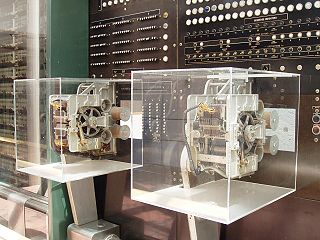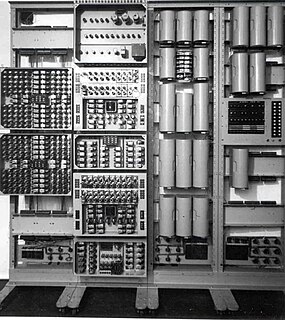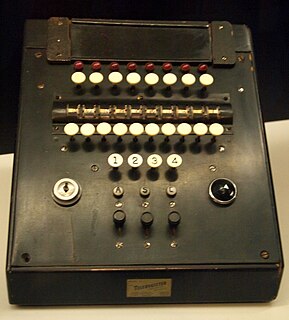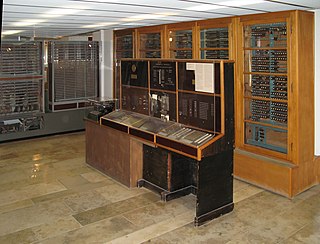 W
WBARK was an early electromechanical computer. BARK was built using standard telephone relays, implementing a 32-bit binary machine. It could perform addition in 150 ms and multiplication in 250 ms. It had a memory with 50 registers and 100 constants. It was later expanded to double the memory. Howard Aiken stated in reference to BARK "This is the first computer I have seen outside Harvard that actually works."
 W
WThe bombe was an electro-mechanical device used by British cryptologists to help decipher German Enigma-machine-encrypted secret messages during World War II. The US Navy and US Army later produced their own machines to the same functional specification, albeit engineered differently both from each other and from Polish and British bombes.
 W
WThe differential analyser is a mechanical analogue computer designed to solve differential equations by integration, using wheel-and-disc mechanisms to perform the integration. It was one of the first advanced computing devices to be used operationally. The original machines could not add, but then it was noticed that if the two wheels of a rear differential are turned, the drive shaft will compute the average of the left and right wheels. A simple gear ratio of 1:2 then enables multiplication by two, so addition are achieved. Multiplication is just a special case of integration, namely integrating a constant function.
 W
WThe IBM Automatic Sequence Controlled Calculator (ASCC), called Mark I by Harvard University’s staff, was a general purpose electromechanical computer that was used in the war effort during the last part of World War II.
 W
WThe Harvard Mark III, also known as ADEC was an early computer that was partially electronic and partially electromechanical. It was built at Harvard University under the supervision of Howard Aiken for the U.S. Navy.
 W
WThe Harwell computer, later known as the Wolverhampton Instrument for Teaching Computing from Harwell (WITCH), or the Harwell Dekatron Computer, is an early British computer of the 1950s based on valves and relays. From 2009 to 2012, it was restored at the National Museum of Computing. In 2013, for the second time, the Guinness Book of World Records recognised it as the world's oldest working digital computer, following its restoration. It previously held the title for several years until it was decommissioned in 1973. The museum uses the computer's visual, dekatron-based memory to teach schoolchildren about computers.
 W
WThe IBM Card-Programmed Electronic Calculator or CPC was announced by IBM in May 1949. Later that year an improved machine, the CPC-II, was also announced.
 W
WThe IBM Selective Sequence Electronic Calculator (SSEC) was an electromechanical computer built by IBM. Its design was started in late 1944, and it operated from January 1948 to August 1952. It had many of the features of a stored-program computer and was the first operational machine able to treat its instructions as data, but it was not fully electronic. Although the SSEC proved useful for several high-profile applications, it soon became obsolete. As the last large electromechanical computer ever built, its greatest success was the publicity it provided for IBM.
 W
WThe Kerrison Predictor was one of the first fully automated anti-aircraft fire-control systems. It was used to automate the aiming of the British Army's Bofors 40 mm guns and provide accurate lede calculations through simple inputs on three main handwheels.
 W
WA mechanical computer is built from mechanical components such as levers and gears, rather than electronic components. The most common examples are adding machines and mechanical counters, which use the turning of gears to increment output displays. More complex examples could carry out multiplication and division—Friden used a moving head which paused at each column—and even differential analysis. One model sold in the 1960s calculated square roots.
 W
WThe Model V was among the early electromechanical general purpose computers, designed by George Stibitz and built by Bell Telephone Laboratories, operational in 1946.
 W
WRangekeepers were electromechanical fire control computers used primarily during the early part of the 20th century. They were sophisticated analog computers whose development reached its zenith following World War II, specifically the Computer Mk 47 in the Mk 68 Gun Fire Control system. During World War II, rangekeepers directed gunfire on land, sea, and in the air. While rangekeepers were widely deployed, the most sophisticated rangekeepers were mounted on warships to direct the fire of long-range guns.
 W
WStarting in 1946, American Airlines developed a number of automated airline booking systems known as Reservisor. Although somewhat successful, American's unhappiness with the Reservisor systems led them to develop the computerized Sabre system used to this day.
 W
WThe SAPO was the first Czechoslovak computer. It operated in the years 1957–1960 in Výzkumný ústav matematických strojů, part of the Czechoslovak Academy of Sciences. The computer was the first fault-tolerant computer – it had three parallel arithmetic logic units, which decided on the correct result by voting, an example of triple modular redundancy.
 W
WSimon was a relay-based computer, described by Edmund Berkeley in a series of thirteen construction articles in Radio-Electronics magazine, from October 1950. Intended for the educational purpose of demonstrating the concept of digital computer, it could not be used for any significant practical computation since it had only two bits of memory. In 1950, it sold for US$600. Some have described it as the "first personal computer", although its extremely limited capacity and its unsuitability for use for any purpose other than as an educational demonstration make that classification questionable.
 W
WThe Torpedo Data Computer (TDC) was an early electromechanical analog computer used for torpedo fire-control on American submarines during World War II. Britain, Germany, and Japan also developed automated torpedo fire control equipment, but none were as advanced as the US Navy's TDC, as it was able to automatically track the target rather than simply offering an instantaneous firing solution. This unique capability of the TDC set the standard for submarine torpedo fire control during World War II.
 W
WThe Z3 was a German electromechanical computer designed by Konrad Zuse in 1935, and completed in 1941. It was the world's first working programmable, fully automatic digital computer. The Z3 was built with 2,600 relays, implementing a 22-bit word length that operated at a clock frequency of about 5–10 Hz. Program code was stored on punched film. Initial values were entered manually.
 W
WThe Z4 was arguably the world's first commercial digital computer. It was designed, and manufactured by early computer scientist Konrad Zuse's company Zuse Apparatebau, for an order placed by Henschel & Son, in 1942; though only partially assembled in Berlin, then completed in Göttingen, and not delivered by the defeat of Nazi Germany, in 1945. The Z4 was Zuse's final target for the Z3 design. Like the earlier Z2, it comprised a combination of mechanical memory and electromechanical logic, so was not a true electronic computer.